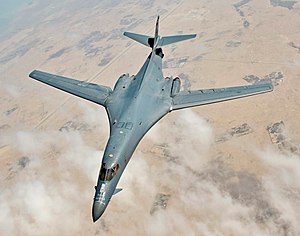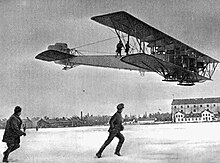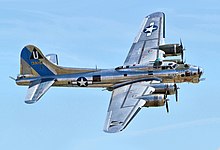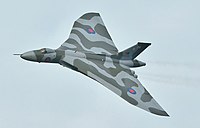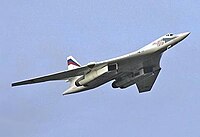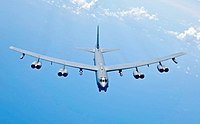
A bomber is a military combat aircraft that utilizes air-to-ground weaponry to drop bombs, launch torpedoes, or deploy air-launched cruise missiles. Bombs were first dropped from an aircraft during the Italo-Turkish War, with the first major deployments coming in the First World War and Second World War by all major airforces, damaging cities, towns, and rural areas. The first bomber planes in history were the Italian Caproni Ca 30 and British Bristol T.B.8, both of 1913. Some bombers were decorated with nose art or victory markings.

The Boeing B-29 Superfortress is an American four-engined propeller-driven heavy bomber, designed by Boeing and flown primarily by the United States during World War II and the Korean War. Named in allusion to its predecessor, the B-17 Flying Fortress, the Superfortress was designed for high-altitude strategic bombing, but also excelled in low-altitude night incendiary bombing, and in dropping naval mines to blockade Japan. B-29s dropped the atomic bombs on Hiroshima and Nagasaki, the only aircraft ever to drop nuclear weapons in combat.

The Tupolev Tu-16 is a twin-engined jet strategic heavy bomber used by the Soviet Union. It has been flown for almost 70 years, Soviets retired many of them after the Cold War ended, however, the Chinese license-built version Xian H-6 remains in service with the People's Liberation Army Air Force, with more being built as of 2020.

Heavy bombers are bomber aircraft capable of delivering the largest payload of air-to-ground weaponry and longest range of their era. Archetypal heavy bombers have therefore usually been among the largest and most powerful military aircraft at any point in time. In the second half of the 20th century, heavy bombers were largely superseded by strategic bombers, which were often even larger in size, had much longer ranges and were capable of delivering nuclear bombs.

A medium bomber is a military bomber aircraft designed to operate with medium-sized bombloads over medium range distances; the name serves to distinguish this type from larger heavy bombers and smaller light bombers. Mediums generally carried about two tons of bombs, compared to light bombers that carried one ton, and heavies that carried four or more.

The Tupolev Tu-4 is a piston-engined Soviet strategic bomber that served the Soviet Air Force from the late 1940s to mid-1960s. The aircraft was a copy of the American Boeing B-29 Superfortress, having been reverse-engineered from seized aircraft that had made emergency landings in the USSR.

The Tupolev Tu-85 was a Soviet prototype strategic bomber based on the Tu-4, an unlicensed, reverse engineered copy of the Boeing B-29 Superfortress. It was the ultimate development of the B-29 family, being over 50% heavier than its progenitor and had nearly double the range. Only two prototypes were built before the program was cancelled in favor of the turboprop powered Tupolev Tu-95 bomber which could cover the same range at a far higher speed.

The Tupolev Tu-80 was a Soviet prototype for a longer-ranged version of the Tupolev Tu-4 bomber, an unlicensed, reverse engineered copy of the Boeing B-29 Superfortress. It was cancelled in 1949 in favor of the Tupolev Tu-85 program which offered even more range. The sole prototype was used in various test programs before finally being used as a target.
The Tupolev Tu-75 was a military transport variant of the Tu-4 bomber, an unlicensed, reverse engineered copy of the Boeing B-29 Superfortress. The Tu-75 was similar to the Tu-70 airliner, both using a new, purpose-designed fuselage. The first Soviet military machine of this class, it was equipped with a rear fuselage loading ramp. It was not placed into production because the VVS decided it would be cheaper to modify its existing Tu-4s for the transport mission and to use its existing Lisunov Li-2 and Ilyushin Il-12 transports.
The Tupolev Tu-70 was a Soviet passenger variant of the Tu-4 bomber, an unlicensed, reverse engineered copy of the Boeing B-29 Superfortress. Designed immediately after the end of World War II, it used a number of components from Boeing B-29s that had made emergency landings in the Soviet Union after bombing Japan. It had the first pressurized fuselage in the Soviet Union and first flew on 27 November 1946. The aircraft was successfully tested, recommended for serial production, but ultimately not produced because of more pressing military orders and because Aeroflot had no requirement for such an aircraft. A military cargo aircraft version was the Tupolev Tu-75.
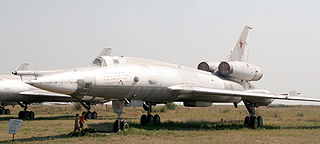
The Tupolev Tu-22 was the first supersonic bomber to enter production in the Soviet Union. Manufactured by Tupolev, the Tu-22 entered service with Long-Range Aviation and Soviet Naval Aviation in the 1960s.
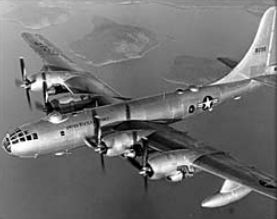
The Boeing B-50 Superfortress is an American strategic bomber. A post–World War II revision of the Boeing B-29 Superfortress, it was fitted with more powerful Pratt & Whitney R-4360 radial engines, stronger structure, a taller tail fin, and other improvements. It was the last piston-engined bomber built by Boeing for the United States Air Force, and was further refined into Boeing's final such design, the prototype B-54. Although not as well known as its direct predecessor, the B-50 was in USAF service for nearly 20 years.

The Myasishchev M-4 Molot was a four-engined strategic bomber designed by Vladimir Mikhailovich Myasishchev and manufactured by the Soviet Union in the 1950s to provide a Long Range Aviation bomber capable of attacking targets in North America.

The Dassault Mirage IV was a French supersonic strategic bomber and deep-reconnaissance aircraft. Developed by Dassault Aviation, the aircraft entered service with the French Air Force in October 1964. For many years it was a vital part of the nuclear triad of the Force de Frappe, France's nuclear deterrent striking force. The Mirage IV was retired from the nuclear strike role in 1996, and the type was entirely retired from operational service in 2005.

The Tupolev Tu-95 is a large, four-engine turboprop-powered strategic bomber and missile platform. First flown in 1952, the Tu-95 entered service with the Long-Range Aviation of the Soviet Air Forces in 1956 and was first used in combat in 2015. It is expected to serve the Russian Aerospace Forces until at least 2040.

The Boeing B-29 Superfortress is a WWII era long range, strategic heavy bomber that was produced in many experimental and production models.

A tail gunner or rear gunner is a crewman on a military aircraft who functions as a gunner defending against enemy fighter or interceptor attacks from the rear, or "tail", of the plane.

A supersonic aircraft is an aircraft capable of supersonic flight, that is, flying faster than the speed of sound. Supersonic aircraft were developed in the second half of the twentieth century. Supersonic aircraft have been used for research and military purposes, but only two supersonic aircraft, the Tupolev Tu-144 and the Concorde, ever entered service for civil use as airliners. Fighter jets are the most common example of supersonic aircraft.
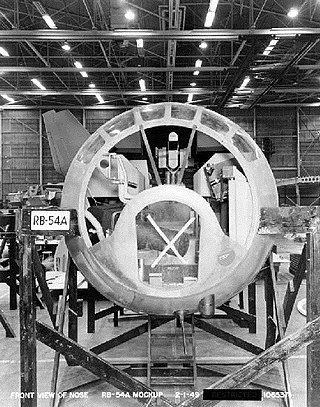
The Boeing B-54 was an American strategic bomber designed by Boeing for use by the United States Air Force. Derived from the YB-50C Superfortress, construction of the prototype was canceled before completion, and the aircraft was never flown.

The Xi'an H-6 is a twin-engine jet bomber of the Chinese People's Liberation Army Air Force (PLAAF). The H-6 is a license-built version of the Soviet Tupolev Tu-16 and remains the primary bomber aircraft of the People's Republic of China.
